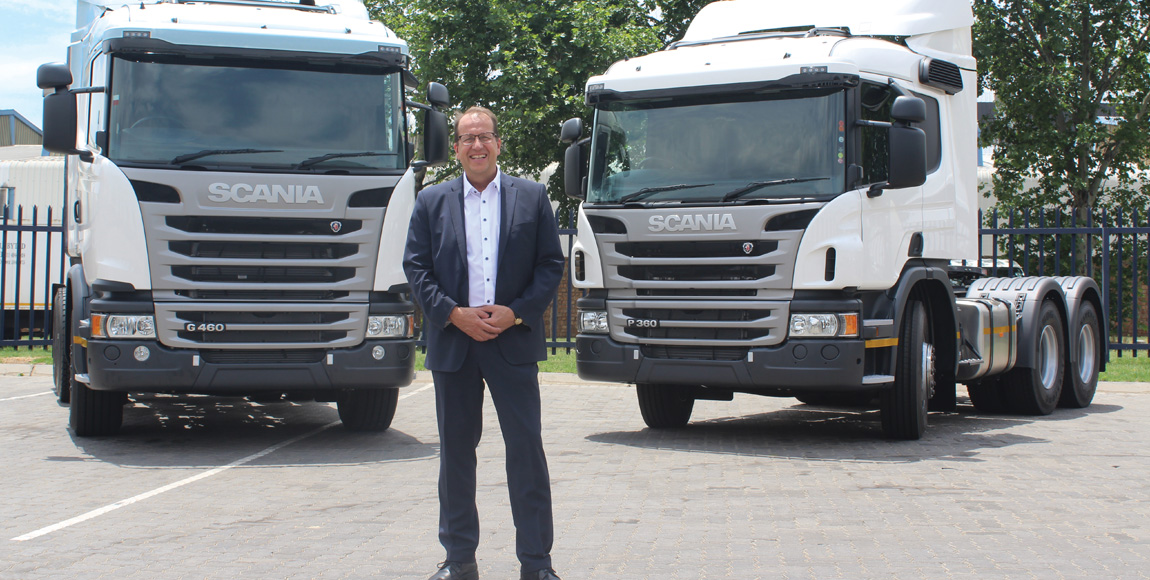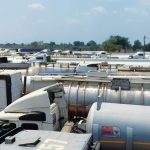Face to face with Raimo Lehtiö

Each month, we chat to one of the captains of industry about pressing issues. This month, CHARLEEN CLARKE goes face to face with Raimo Lehtiö, MD of Scania South Africa.
Please provide our readers with some background about your career – you have worked all over the world … Finland, Russia, the Far East, Estonia, Latvia and Lithuania to name but a few. What roles have you held and what were your greatest achievements during these times?
I started working in Norway, at the age of 19. I was responsible for the plumbing team at a paper mill. Then I joined ABB and spent 20 years with the company. I went through some interesting times; at one stage I was responsible for a market bigger than South Africa. I was travelling 170 days a year and I was also studying for my MBA!
During my time with ABB, I spent time in all the Nordic countries and also in Russia and Libya. The latter was especially interesting, because it was my first time in an Arab country.
Then, 17 years ago, I joined Scania, starting as the MD in Finland. I ran the Finnish company for three years and then I took over the Russian company. I was there for four years. So, in total (taking into account my five years with ABB in Russia), I spent nine years working in Russia. It was enough hardship (lots of laughter). It was really tough when I arrived there the second time around – but we enjoyed massive growth.
When I joined Scania Russia, we sold 1 400 vehicles a year. By the time I left, we were selling 5 800 vehicles. Then I was appointed regional director for the Eastern Europe and Northern Asian region. I was also sitting on the boards of Scania China, Korea, Hong Kong, Taiwan, Russia, Ukraine and Kazakhstan.
That was one of the most interesting times in my career, because I was still MD in Russia. It was a really busy time; it involved a lot of hours, a lot of travelling and a lot of positive stress.
Was that the most challenging time in your career?
It certainly was. It was incredibly challenging to be both MD of Russia and regional director.
I did both jobs for one year and four months. I need to say a big thanks to my wife. Incredibly, we are still married! (Lots of laughter.)
When I moved to Russia I could not take my family with me because my boys were going to university … so I had to make some big sacrifices. I also had to learn how to prioritise. I could not have done this without the support of my wife. When you have a job as demanding as mine, you really rely on team playing within the family environment…
I have been extremely lucky to have a wife who supported me while working on her own career at the same time. She is a dentist and a very successful one at that; I am very proud of her.
You experienced various different cultures during this time. That must have been interesting?
It certainly was. I learnt about the Arab world in Libya. While there I came to realise the importance of Arab people leading companies. Even a foreign company needs to be led by an Arab. That is very important in their culture.
I also learnt about the Russian way of doing business (luckily, I was moderately fluent in Russian at the time); they are very direct. I also learnt about doing business in Asia, where is it very important not to lose face.
Each country is unique. In South Africa, for instance, it is quite informal. People are frank, informal and very nice.
When the opportunity arose for you to come to South Africa, were you keen, and, if so, why?
South Africa was always a dream for me. I knew the South African nature. I like the bush and I am a huge fan of motorcycles (I have three BMW off-road bikes and one Harley). I knew that I would be able to ride here!
In Russia, I did 30 000 km on my bikes and I have used them a great deal in South Africa, too; I have been on two long road trips, mainly off-road. I have also been to Lesotho and visited the Golden Gate National Park.
The best thing, however, is that my wife has now retired, and she is living in South Africa with me! I’m really happy about that.
What were your main business goals/objectives for your time as MD of Scania South Africa? Do you feel that you have achieved these thus far?
I came to South Africa at a time when little growth was expected – so I came here to consolidate the business (after some years of extremely fast growth). I turned my attention to improving all aspects of the business.
Just one was in the area of used trucks. We had more than 800 used vehicles in stock when I arrived; we now have 250. I focused on growth within the services aspect of our business and I am delighted to report that this division has grown by 15 to 20 percent each year during my time here!
Furthermore, we had too many demo trucks and there was insufficient control of these vehicles. I am pleased to report that our balance sheet is much cleaner now and we are more profitable.

But you’re not only focusing on profitability, right?
Definitely not. My goal is also on higher customer satisfaction; this is far more important than market share. My focus has been on building the brand rather than getting rubber on the road.
I focus on the market share of souls. We want to offer the customer the right vehicle, with the best fuel consumption and the right carrying capacity. Some of our competitors sell the rubber that they have in the yard, without considering exactly what the customer actually needs. That is not how we do business.
I believe that you have also concentrated on growing other parts of the business (as opposed to just focusing on new-vehicle sales). Is this correct?
Yes. We have been concentrating on used trucks and I can happily to report that we sold 1 700 used vehicles last year. We have been focusing on developing Scania Finance, and we are now financing two thirds of new-vehicle sales and 40 percent of used sales (versus 20 percent in the past).
Growing the market share in services is very important. This business is not just about new vehicle sales. It is about offering a total package and making our customers more profitable.
Harking back to your days in Siberia, I have noticed that you are also growing your dealer network here in South Africa. Please tell us more.
We have opened a dealership (that we own) in Port Elizabeth. There was a private dealer in Port Elizabeth previously, which was not professional enough.
We have also opened a new dealership (which we also own) in Walvis Bay. In Windhoek, we have invested in a panel, paint and accident-repair facility, which is unique within our industry. Previously the vehicles were actually towed to South Africa for repairs.
We are now opening a dealership in Musina (we have a strong BEE partner there). We have also opened a new dealership in Nelspruit and one in Maputo.
We are not only growing our network, however; we are making better use of current facilities. For instance, since the beginning of this year, we have offered extended servicing hours at our biggest dealerships (from 07:30 to 22:00).
At our Harrismith dealership, servicing is offered until 23:00. It is also possible to pre-schedule a service later than that (even 02:00 is no problem). I am confident that our service network is ready for the growth that will come.
You mention Maputo. How are you performing in Mozambique and other export markets?
Well, I am responsible for seven countries: South Africa, Namibia, Botswana, Mozambique, Zimbabwe, Zambia and Malawi. We are the market leader in Namibia, Botswana and Mozambique. Our success in Mozambique is quite extraordinary because we only started the company there three years ago! Recently, we delivered 50 new vehicles to Grindrod in Mozambique, which was a real coup.
Based on your experience, how do South African transport operators compare to Scania customers elsewhere in the world?
There are many professional transport operators in South Africa. Normally, outside of Europe, only about a quarter of the transport operators are truly professional. This statistic does not apply to South Africa. This is a mature market, where at least 40 percent of the operators are really professional.
It’s very nice to work with them. South African customers are open and honest – much more so than in any other markets. Here, if you are open, we can work together as partners quite fast. This takes far longer in other markets.
Connectivity is a big thing in the Scania world. Is it a big deal here in South Africa too?
Absolutely. We have thousands of connected vehicles. This has allowed us to offer flexible maintenance plans. If an operator has good drivers, service intervals can be extended as a result.
You have previously spoken about sustainability, which is one of Scania’s main global focus areas. What does sustainability mean for Scania South Africa and for local operators?
I believe that there is potential for us to sell gas- and biodiesel-powered vehicles. Ethanol is not really of interest in this market. In the short term, electric vehicles are not of interest although hybrids may work. Long term, electric vehicles will be a must.
I am glad to hear this, because I have been writing a lot about electric trucks lately. When do you think South African operators will be ready for electric trucks?
That depends on costs. According to a Scania study, biofuels are an appropriate bridge technology in the transition to a fossil-free commercial-transport system. We believe that electric vehicles should become popular by 2031, when the average total cost of ownership for electric vehicles in all segments should be level with diesel.
Your company has a strong record of success. Six years ago, you had a seven- or eight-percent share of the extra-heavy market. By 2017, you had a 16-percent share – and a 22,5-percent share of the bus market. What is the current market situation? What were your market-share aspirations for 2018? Are you on track to achieving them?
The first thing that I must stress is that we look at market share differently. We also take into account the market share of services. That’s more important than market share of units, but we will take more market share at the end of this year.
We had a tough start to the year. We had volume restrictions due to a lack of stock. We could easily have sold hundreds more vehicles. Despite this, we will maintain our 16-percent share of the extra-heavy truck market.
When it comes to buses, we are keeping our share. We are number two in this segment, and in many export markets we are number one. We are doing very well in front-engine sales to rural areas, but our Touring is also taking off (we will sell 30-percent more than last year and we are expecting further growth of another 30 percent next year).
We will end up with around the same share of the bus market – about 22,5 percent. Importantly, there will be a sustainable balance between volume and market share.
Studying the Naamsa statistics, at face value it may seem as though Scania South Africa is losing market share to Volvo. Is this a fact? If so, is there a particular reason for this that the market may not be aware of?
Definitely not. Other manufacturers may be losing market share to Volvo, but we are not.
South Africa is officially in a recession. How are you reacting to this?
We are cementing our relationships with existing customers and developing new relationships with others. We are especially excited about the relationships we have formed with smaller black-owned companies with whom we are working.
We are focusing on the positive aspects of the business – driver training, for instance, which benefits our customers. We are also doing more training internally, so that we can deliver even better service.
Some of the European truck manufacturers are battling to meet demand. Is this the case with Scania?
Yes, we battled with stock in quarter four last year and quarter one this year. Hopefully this is now a thing of the past.
Has Scania South Africa been affected by the strike at one of its main casting suppliers, which caused massive delays in V8 production?
No, fortunately not. That only affected Europe. The shortage only pertained to Euro-6 engines, which is why we were not impacted. We could source as many Euro-3 V8s as we needed.
There is talk of a new Scania truck range to be launched in South Africa very soon. Is this the case? If so, do you have further details that you can share around the expected date of arrival?
I can only mention that Latin America (from where we get our kits) is moving its production to the new range. We will get the new truck in 2019 or 2020; we don’t know yet. We are not in a hurry – because we have a really good vehicle presently.
Finally, you’ve been here since mid-2016. How much longer will you stay in South Africa?
Well that is hard to say. According to my contract I should retire next year, but you never know! I have had a busy and enjoyable two years. I hope that I can stay here for a couple more years.
Of course, the economy is not good, but we are doing well, and we have great people in the company, and so I am very pleased with the current situation.
Published by
Charleen Clarke
focusmagsa




